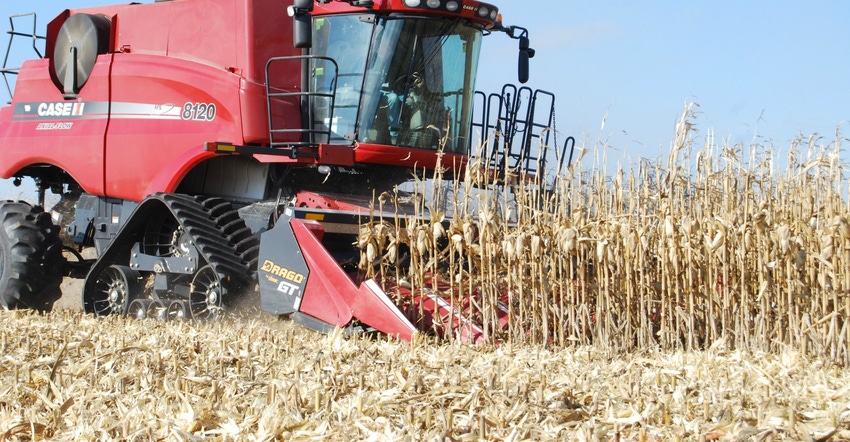
Another week of storms bringing heavy rainfall to much of the state left Iowa farmers just three days suitable for fieldwork during the week ending Sept. 23, according to the weekly statewide survey by USDA’s National Ag Statistics Service. Activities for the week included seeding cover crops and harvesting corn, soybeans and hay.
The statewide survey shows 5% of Iowa’s 2018 corn for grain crop has been harvested, five days ahead of both last year and average. And 8% of the state’s soybean crop has been harvested, five days ahead of average.
More farmers are going ahead and harvesting corn and paying for propane to dry it artificially in a grain drier or with an in-bin drying system, rather than let corn stand and wait for it to dry down more on the stalk in the field. With the wet weather, many parts of Iowa have had recently, farmers want to avoid development of mold on ears, so they’re harvesting corn grain wetter than normal and artificially drying it.
How fast will corn dry down in field?
Some areas of Iowa have swung between warm-dry and cool-wet weather within the last week. With more rain in the forecast, you may be wondering how fast corn will dry down in the field in coming weeks. What factors are associated with grain drydown when the ear is still on the stalk?
“In a nutshell, after the crop has reached maturity, the rate of grain drydown is largely driven by air temperature and relative humidity,” says Iowa State University Extension agronomist Mark Licht.
“Corn grain drydown is typically not a concern during a warm, dry fall,” he notes. “Grain moisture often reaches near 15% by mid-October. However, with cool, wet weather, it may take until early to mid-November to reach 15%.” Corn grain moisture of 15% or less is considered safe for storage during winter and into spring.
Southeast Iowa leads with 19% harvested
Farmers in southeast Iowa already have 19% of their corn harvested, the Sept. 23 survey shows. The complete weekly Iowa Crop Progress and Weather Report is at iowaagriculture.gov and nass.usda.gov/ia.
Crop report
Topsoil moisture as of Sept. 23 rated 1% very short, 3% short, 71% adequate and 25% surplus. Subsoil moisture rated 3% very short, 5% short, 66% adequate and 26% surplus. While topsoil moisture supplies have improved in south-central Iowa, subsoil moisture levels still rated 62% short to very short.
Nearly all of Iowa’s 2018 corn crop has reached dent stage or beyond, with 74% of the crop mature, just over a week ahead of average. The statewide survey shows 5% of the corn for grain crop has been harvested, five days ahead of both last year and the average. Farmers in southeast Iowa lead the way with almost one-fifth of their corn for grain harvested.
Corn moisture averages 22%
Moisture content of field corn being harvested was at 22% last week. Corn condition is rated 73% good-to-excellent.
Looking at Iowa’s soybean crop, 93% of the acres were coloring with 72% dropping leaves, one week ahead of average. The survey shows 8% of the soybean crop has been harvested, five days ahead of average. Soybean condition is rated 72% good-to-excellent.
The third cutting of alfalfa hay as of Sept. 23 was nearly complete at 97%. Pasture conditions improved slightly to 52% good-to-excellent. Rain and cooler temperatures have been beneficial for pasture regrowth. Feedlots will need some time to dry.
Weather summary
According to Justin Glisan, IDALS climatologist, after an extremely dry week, an active weather pattern returned, bringing above-average rainfall to most of Iowa for the week ending Sept. 23. Average temperatures were also up to 10 degrees above normal. Sept. 17 was generally quiet and warm until thunderstorms raced across northern Iowa in the late afternoon. Some storms turned severe; large hail and high winds were reported in Hancock County. Sioux City (Woodbury County) recorded 2.29 inches of rain.
On Sept. 18, thunderstorms were widespread with heavy rain over northern Iowa. Spencer (Clay County) reported 3.04 inches, 2.92 inches above normal. Nearly 15 stations recorded rainfall above 2 inches. Severe weather was reported in six counties. Tree damage from straight-line winds and 1-inch-diameter hail struck Jasper County.
Thunderstorms with heavy rain continued across Iowa’s northern third Sept. 19-20, leading to widespread flood warnings.
Two-day rain totals were 2 to 5.19 inches above average for over 30 stations. Everly (Clay County) reported 5.51 inches. Temperatures over this period were hot, with many locations 10 to 15 degrees above average. High temperatures ranged from the mid-80s into the mid-90s, except for northern Iowa where rain and cloud cover kept temperatures cooler.
Iowa’s high 96, low 36
A cold front with severe thunderstorms crossed the state the evening of Sept. 20. Twelve western counties reported severe winds with 75-mph gusts in Emmet County. The cold front exited Iowa on Sept. 21, bringing dry conditions and pleasant temperatures through the weekend.
Average highs over the weekend were in the upper 60s to low 70s. Overnight lows dipped into the 40s, with Cresco (Howard County) and Waukon (Allamakee county) recording the week’s low temperature of 36 degrees, 7 degrees below normal. Williamsburg (Iowa County) observed the week’s high temperature of 96 degrees Sept. 18, 21 degrees above average.
About the Author(s)
You May Also Like




